mishra lab
Manoj K. Mishra, Ph.D.
Professor of Biology
Director, Cancer Research Center
Department of Biological Sciences
Email: mmishra@alasu.edu
Tel: 334-604-8410
Orcid ID: https://orcid.org/0000-0001-7563-6474
LinkedIn: https://www.linkedin.com/in/manoj-k-mishra-41055420/
BIOGRAPHY

Dr. Mishra received his M.Sc. and Ph.D. degrees from Banaras Hindu University, Varanasi, India. After obtaining a Ph.D., he moved to the United States and did postdoctoral training in the Division of Biology, Kansas State University, Manhattan, KS; the Division of Allergy and Immunology, Department of Pediatrics, Washington University School of Medicine, St. Louis, MO; and the Division of Rheumatology, Department of Pediatrics at Medical College of Wisconsin, Milwaukee, WI. In 2006, he continued at the Medical College of Wisconsin. He moved into the Division of Allergy and Clinical Immunology within the Department of Pediatrics as a Research Scientist before coming to Alabama State University (ASU) in February 2009.
He also serves as the founding director of ASU's Cancer Research Center (formerly known as Cancer Biology Research and Training-CBRT) and Freshman Biology Programs. Since February 2011, he has also held an adjunct Professor Position in the Division of Molecular and Cellular Pathology within the Department of Pathology, School of Medicine at the University of Alabama at Birmingham, AL. His lab receives research and educational grants from the National Institutes of Health, the American Cancer Society, and the National Science Foundation. He was recognized as one of the Top 25 Professors at an HBCU in 2013 and received awards for my Research work at ASU. He has been identified and won many prizes, such as the faculty scholar in cancer award from the American Association of Cancer Research (2013, 2015, 2016), undergraduate faculty award from the American Association of Immunologists (2014, 2015), junior faculty award from American Association of Immunologists (2010, 2011, 2012) and many other awards for his academic achievements. In 2015, he received the prestigious STEM Faculty of the Year award at Alabama State University. In 2022, he received outstanding achievement awards from the Society of American Asian Scientists in Cancer Research (SAASCR). He was also named a Fellow of the Association of Biotechnology and Pharmacy (FABAP) in 2022. He serves on editorial boards of many peer-reviewed journals, has edited three books on cancer research and public health, published more than 50 peer-reviewed research papers, and has more than 100 conference presentations. Since 2011, he has successfully received external funding totaling over 12 million dollars (13 grants completed, and five are current). He developed the first-ever cancer program at Alabama State University. He spearheaded a partnership between ASU and UAB Comprehensive Cancer Center that fetched more than 1.5 million dollars in NIH funding. In 2019, he developed another collaboration with Tuskegee University, Savannah State University, Vanderbilt University, and the University of North Texas Health Science Center and successfully received $3 Million in funding from NIGMS. He regularly serves on the National Institutes of Health and National Science Foundation and US Department of Defense study panels. He supported more than 60 students through grants funded by different funding agencies. He serves as P.I.s on five federal NIH, ACS, and NSF-funded federal grants (more than $7.5 million). He also serves as a member of various professional organizations, including the American Association of Cancer Research, the Alabama Comprehensive Cancer Control Coalition, and the American Association of Immunologists. Dr. Mishra's education interests revolve around training, mentoring, and providing opportunities to undergraduate and graduate students, mainly from underrepresented populations. His research interest focuses on broader areas of immunology, tumor biology, and health disparity, using prostate cancer as a model system. Dr. Mishra's lab currently investigates the roles of dietary compounds, microbial metabolites, and immune cells, especially regulatory T and NK cells, in prostate cancer development and progression.
RESEARCH INTERESTS
Currently, our group is engaged in the following projects:
- Role of immune cells in prostate cancer clearance: We want to understand the role of TGF beta and regulatory T cells (TR) in cancer
development. Prostate cancer (PCa) is the most common non-skin malignancy and the
cancer second most responsible for death for men in the United States. Prior studies
with animal models of PCa and humans demonstrated that the prostate produces various
growth factors. The addition of blocking these factors alters PCa cell proliferation
and other functions. Among these factors, transforming growth factor-β1 (TGF-β), which
is involved in tumorigenicity, displays potent immunosuppressive activities and is
required to convert conventional CD4+ T cells to FoxP3+ regulatory T cells. The TR
cells that express the transcription factor Foxp3 are essential for normal immune
function; the absence of the TR cells results in multi-organ autoimmunity and death.
The role of TGF-β and its effect on the TR during PCa development and progression
lacks experimental evidence. Additionally, we have shown how phytophenol modulates
immune cells, thereby changing their role in the tumor microenvironment and related
epigenetic mechanisms in prostate cancer progression and clearance.
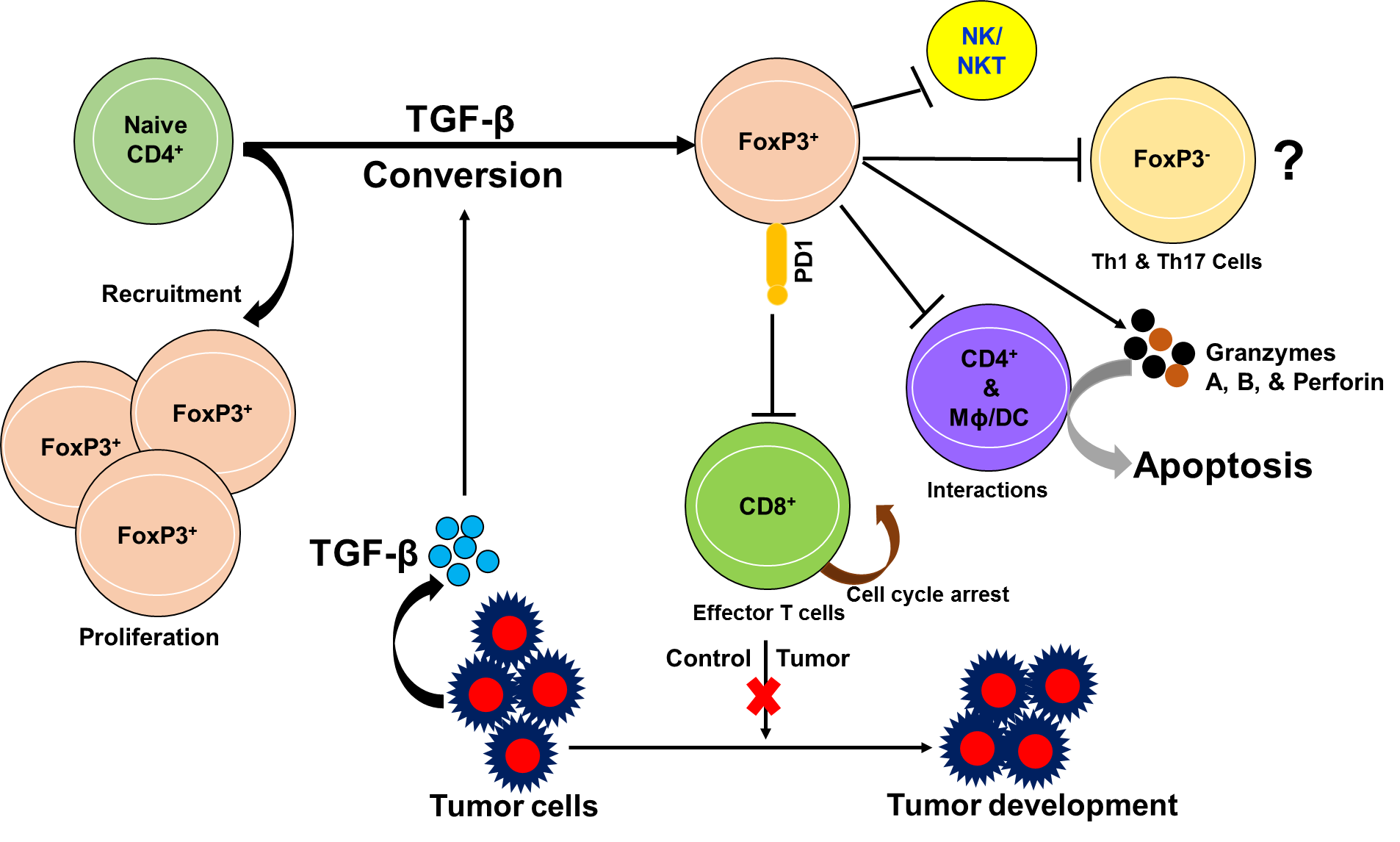
- Molecular interplay of Epigenetically regulated Epithelial-Mesenchymal transition
in triple-negative breast cancer: The aggressive nature and genome complexity of triple-negative breast cancer (TNBC)
make it vital among other breast cancer subtypes [1]. TNBC accounts for approximately
9% to 20% of all breast carcinomas compared with HR-positive BCs; TNBC has a worse
prognosis. The current therapeutic options are limited to standard surgery, adjuvant
chemotherapy, and radiotherapy; however, many patients have missed the surgical window
at diagnosis [2]. Therefore, there is an urgent need to develop a new therapeutic
strategy to unravel the novel drug targets against TNBC. Different methods have been
adopted in the last decade but have limited success compared to other types of breast
cancer [3]. Current data suggests that epigenetic alterations drive the initiation
and evolution of breast cancer. These epigenetic modifications involve DNA methylation,
chromatin remodeling, and non-coding RNAs play a fundamental role in TNBC pathogenesis.
The extracellular matrix (ECM) undergoes significant structural changes that induce
proliferation, migration, adhesion, invasion, and epithelial-to-mesenchymal transition
(EMT) [4]. EMT defines the biological process by which epithelial cells lose adhesion
and gain migratory and invasive properties (mesenchymal characteristics) crucial in
initiating tumor cell migration and metastasis development [5].
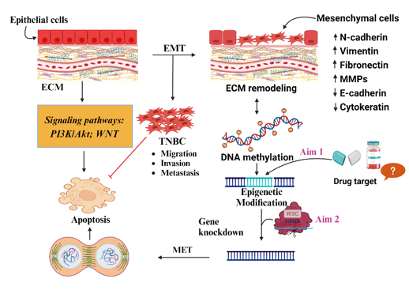
- Social Determinants of Health and their Impact on Prostate Cancer Health Disparities: Studies underline evidence that socioeconomic status (SES) is closely associated
with health care and, notably, prostate cancer (PC) prevalence. Alabama is one of
the geographic locations that faces high cancer prevalence. Associating SES status
with PC prevalence is timely and noteworthy. The impoverished deep south state of
Alabama is the focus of this research. Alabama is well known for the historical and
cultural landscape of Black Belt Counties (BBC), predominantly occupied by African
American populations who were systematically undermined in socioeconomic, healthcare,
educational, employment, and political aspects. This research explores PC prevalence
in the major ethnic groups (African American and White) in Alabama, mainly in the
BBC. We hypothesized that PC prevalence is closely associated with SES. In particular,
the poor status of SES severely influences PC patients from access to healthcare,
healthy food, education, employment, transportation, and screening. Our study explores
the impact of selected SES factors such as education, income, employment, and poverty
to understand PC prevalence in Alabama, particularly in the impoverished BBC. We utilize
Geographic Information Systems to analyze the connection between PC prevalence and
SES. This study incorporates county-level PC prevalence and association with SES,
such as education, income, employment, and poverty. The research contained data from
diverse sources (U.S. Census, State Cancer Profile, Department of Health, American
Cancer Society, National Cancer Institute, and published peer-reviewed journals).
Integrating geospatial and non-spatial data on PC prevalence with these specified
factors helps predict and formulate PC prevention methods and promote health policy
formulation.
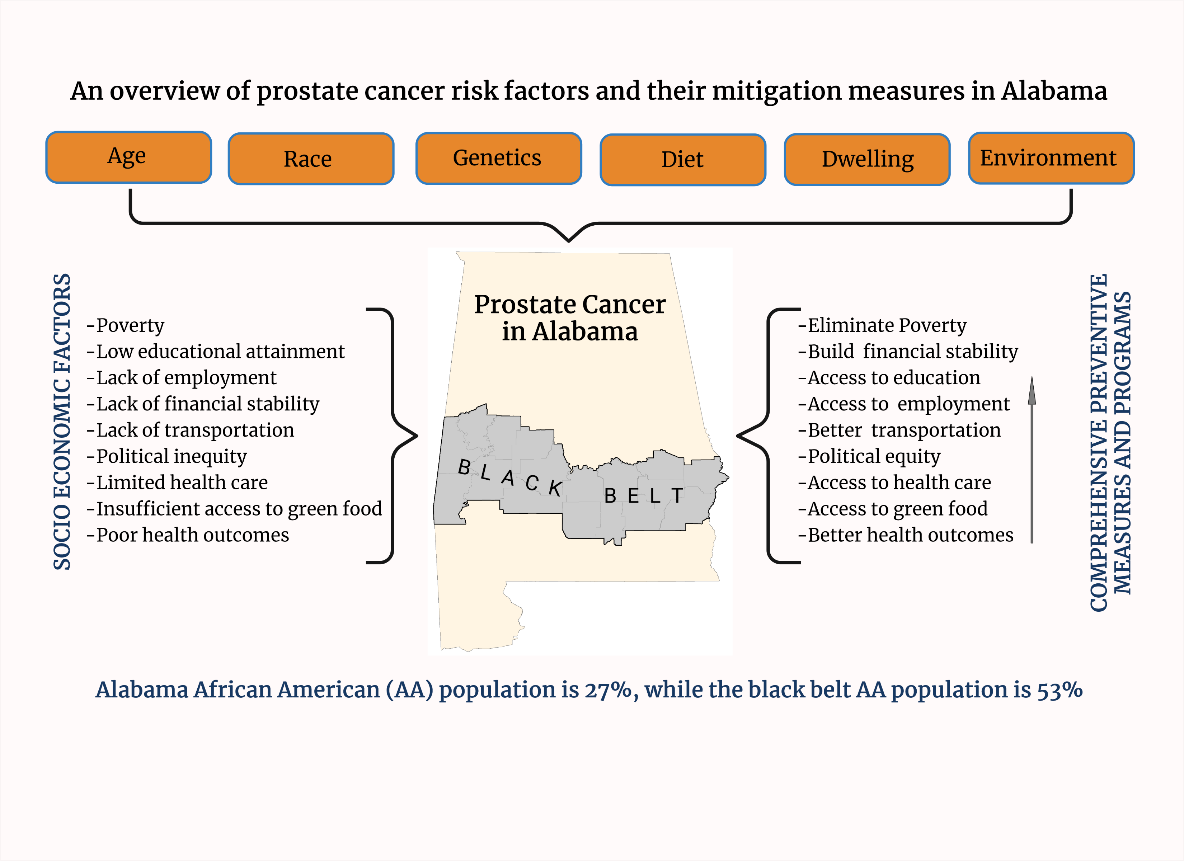
CURRENT LAB MEMBERS
Ritish Shyanti, Ph.D., Research Scientist
Email: rshyanti@alasu.edu
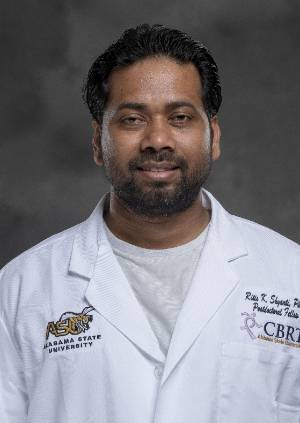 Dr. Ritis Shyanti is working as a Research Scientist in the Cancer Biology Research
and Training Program (CBRT), Biological Sciences at Alabama State University (ALASU).
His research is focused on basic biomedical science in cancer biology and training
students in biomedical techniques. He has a broad background in cancer biology research
and drug screening on different cancer models (in vitro and in vivo).
Dr. Ritis Shyanti is working as a Research Scientist in the Cancer Biology Research
and Training Program (CBRT), Biological Sciences at Alabama State University (ALASU).
His research is focused on basic biomedical science in cancer biology and training
students in biomedical techniques. He has a broad background in cancer biology research
and drug screening on different cancer models (in vitro and in vivo).
Current Project and Research Interest:
Project Title: NKT (Natural Killer T) cells dependent and independent CD1d interaction and its impact on breast cancer.
Dr. Shyanti was recently awarded the Clinical Scientist Developmental Grant funded by the American Cancer Society. The project is focused on "Exploring CD1d's Function in Regulating Breast Cancer Pathophysiology," which can significantly enhance our comprehension of breast cancer metastasis and resistance to therapy. The study concentrates on the role of CD1d in disease progression through the direct or indirect modulation of Natural Killer T cells and identifying CD1d's potential in both detection and therapeutics. Besides this, he is working on cancer stem cells, metastasis, and drug resistance associated with prostate, colon, and breast cancer. Further, his idea is to explore the targeted therapy that can be achieved by using phytochemicals and drugs that selectively target cancer and cancer stem cells and improve tumor immunity.
Parul Dubey, Ph.D., Research Scientist
Email: parul.dubey04@gmail.com
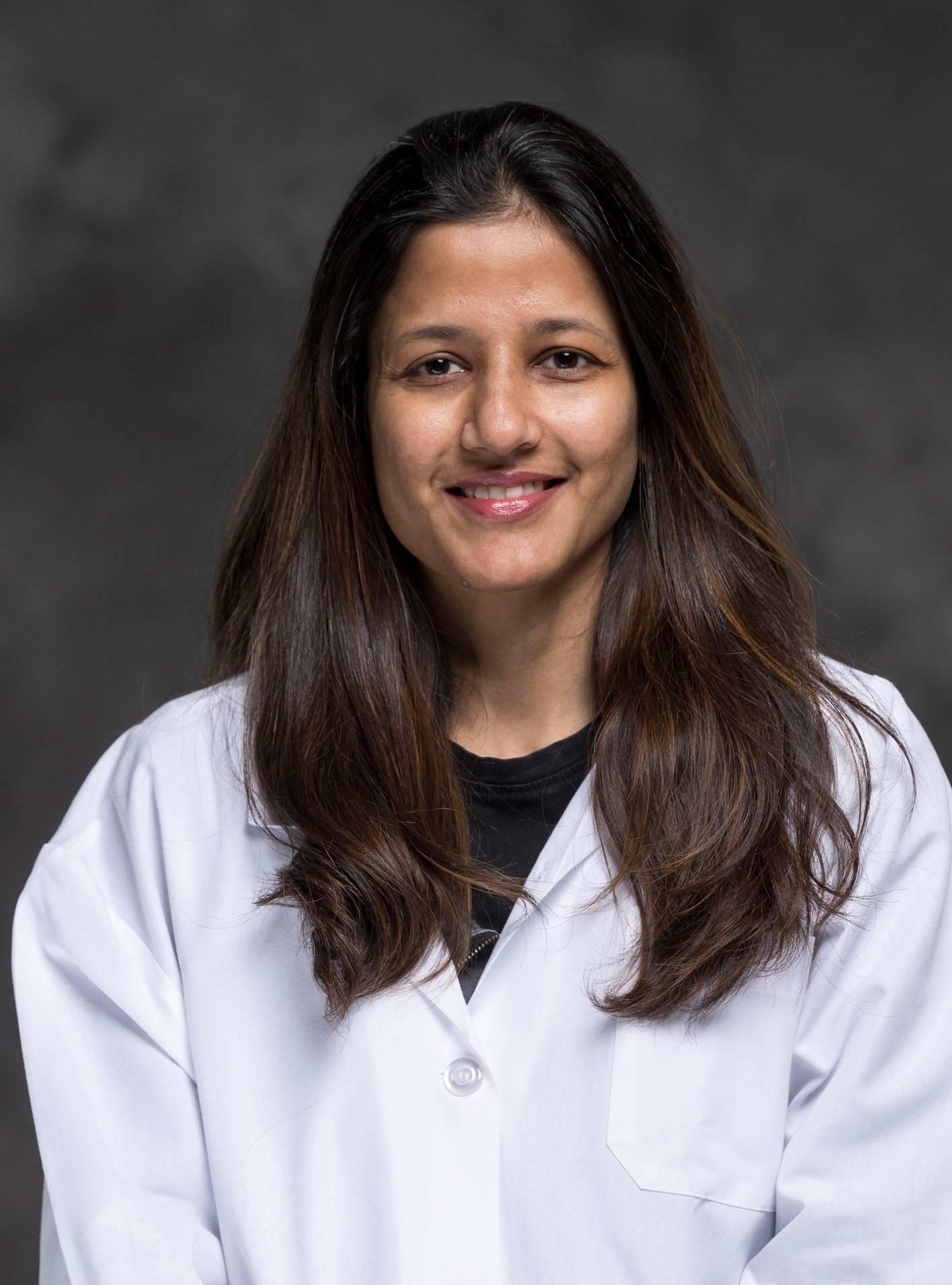 Dr. Dubey has an impressive research background and has dwelled deep into cancer biology.
Her work spans various aspects of cancer research, beginning with her doctoral studies.
She earned her Ph.D. from King George's Medical University, India, where her research
was focused on identifying predictive cancer stem cell biomarkers in head and neck
squamous cell carcinoma patients and its correlation with radiotherapy resistance.
Dr. Dubey has an impressive research background and has dwelled deep into cancer biology.
Her work spans various aspects of cancer research, beginning with her doctoral studies.
She earned her Ph.D. from King George's Medical University, India, where her research
was focused on identifying predictive cancer stem cell biomarkers in head and neck
squamous cell carcinoma patients and its correlation with radiotherapy resistance.
Following her doctoral studies, she served as a Project Associate in the Department of Cancer Biology at CSIR-Central Drug Research Institute, India. Her work focused on elucidating the underlying molecular mechanisms regulating the overactivation of oncogenic kinases in aggressive cancers. In December 2022, she relocated to the USA and became a Postdoctoral Fellow at the Clinical Sciences Laboratory at H. Lee Moffitt Cancer Research Center. During this period, her research centered on murine nitric oxide models for melanoma therapy. In December 2023, she joined the Cancer Research Center (CRC), Department of Biological Sciences at Alabama State University. Currently, she holds the position of Research Scientist in CRC, where she is engaged in two key projects: unraveling the role of cellular prion protein (PrPc) in breast cancer through the Wnt Signaling Pathway and Investigating the Role of Glutathione Metabolism in CD8+ T-cell Dysfunction and improve Immunotherapy Outcomes in Prostate Cancer. Dr. Dubey has been awarded a two-year pilot grant from the Breast Cancer Research Foundation of Alabama for her project "Bridging the Gap: Integrating Genetic Insights and FDA-Approved Therapies to Revolutionize Treatment for African American Breast Cancer." Additionally, she secured a four-year Clinical Scientist Development Grant from the American Cancer Society for her work on "Investigating the Role of Glutathione Metabolism in CD8+ T-cell Dysfunction and Improving Immunotherapy Outcomes in Prostate Cancer."
Funded grant:
BCRFA grant (Dubey- PI). 1/1/2025-12/31/2026, 0.1 calendar month, Breast Cancer Research Foundation of Alabama,
Bridging the Gap: Integrating Genetic Insights and FDA-Approved Therapies to Revolutionize Treatment for African American Breast Cancer
Mazharul Haque, Ph.D., Postdoctoral fellow
Email: mhaque@alasu.edu
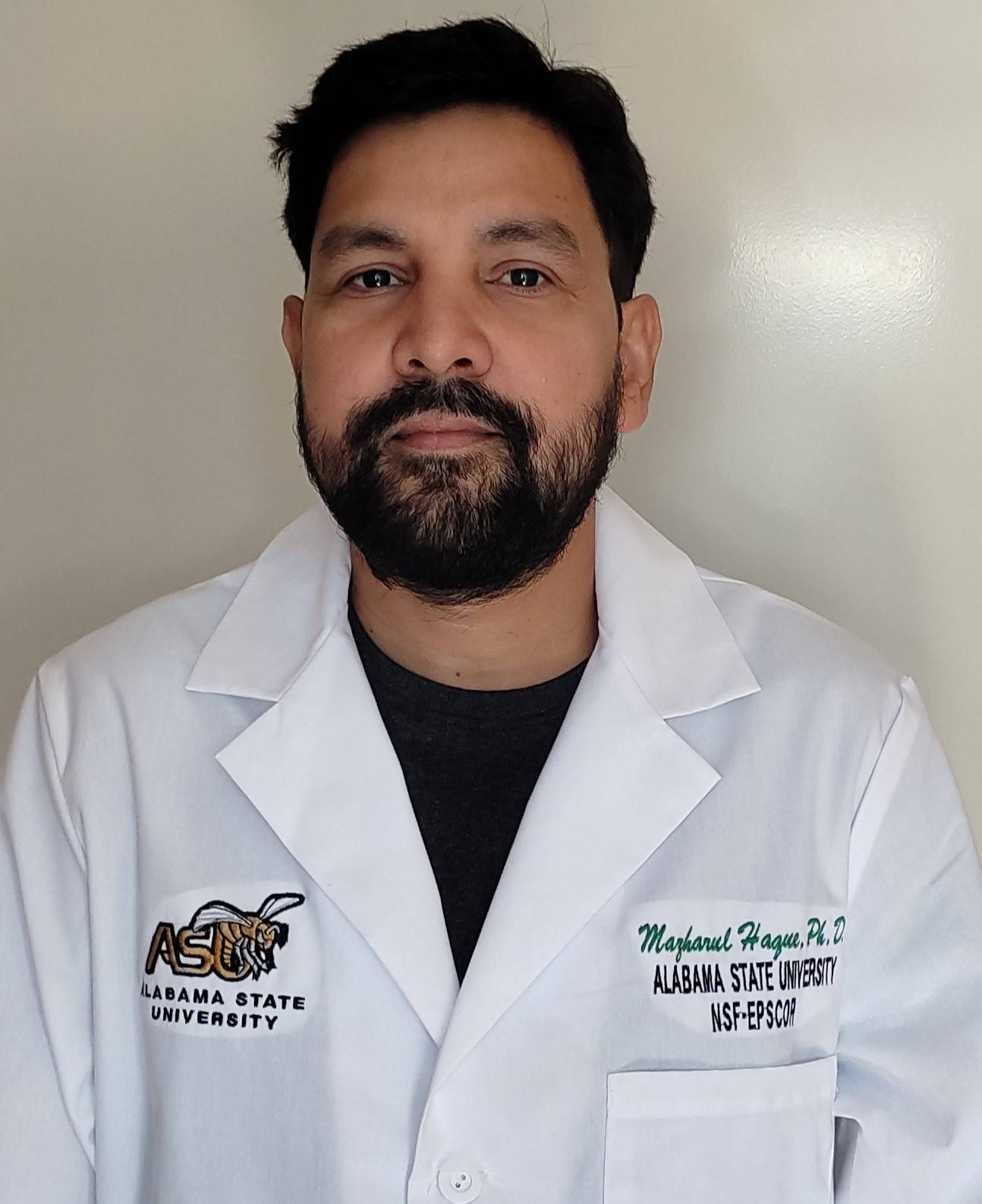 Dr. Mazharul Haque is a dedicated cancer biologist with a strong molecular oncology
and regenerative medicine background. He earned his master’s in Biotechnology and
completed his Ph.D. at the Centre for Interdisciplinary Research in Basic Sciences,
Jamia Millia Islamia, New Delhi, India. Following his doctoral studies, he moved to
the United States, serving as a Postdoctoral Research Associate at Alabama State University.
Dr. Mazharul Haque is a dedicated cancer biologist with a strong molecular oncology
and regenerative medicine background. He earned his master’s in Biotechnology and
completed his Ph.D. at the Centre for Interdisciplinary Research in Basic Sciences,
Jamia Millia Islamia, New Delhi, India. Following his doctoral studies, he moved to
the United States, serving as a Postdoctoral Research Associate at Alabama State University.
Dr. Haque's research centers on understanding the molecular crosstalk between epigenetic alterations and gene regulation in tumorigenesis. His work aims to unravel the complex regulatory mechanisms that drive cancer progression and identify novel therapeutic targets to attenuate tumor growth. He is particularly interested in exploring how epigenetic modifications influence oncogenic signaling pathways, leading to innovative treatment strategies.
In addition to his contributions to cancer research, Dr. Haque is actively involved in biomaterials and tissue engineering, focusing on designing and developing 3D scaffolds for tissue regeneration, wound healing, and cancer therapeutics. His interdisciplinary expertise bridges molecular biology and bioengineering, enabling the translation of fundamental research into clinically relevant applications.
Dr. Sudhanshu Sharma, Ph.D., Postdoctoral fellow
Email: ssharma@alasu.edu
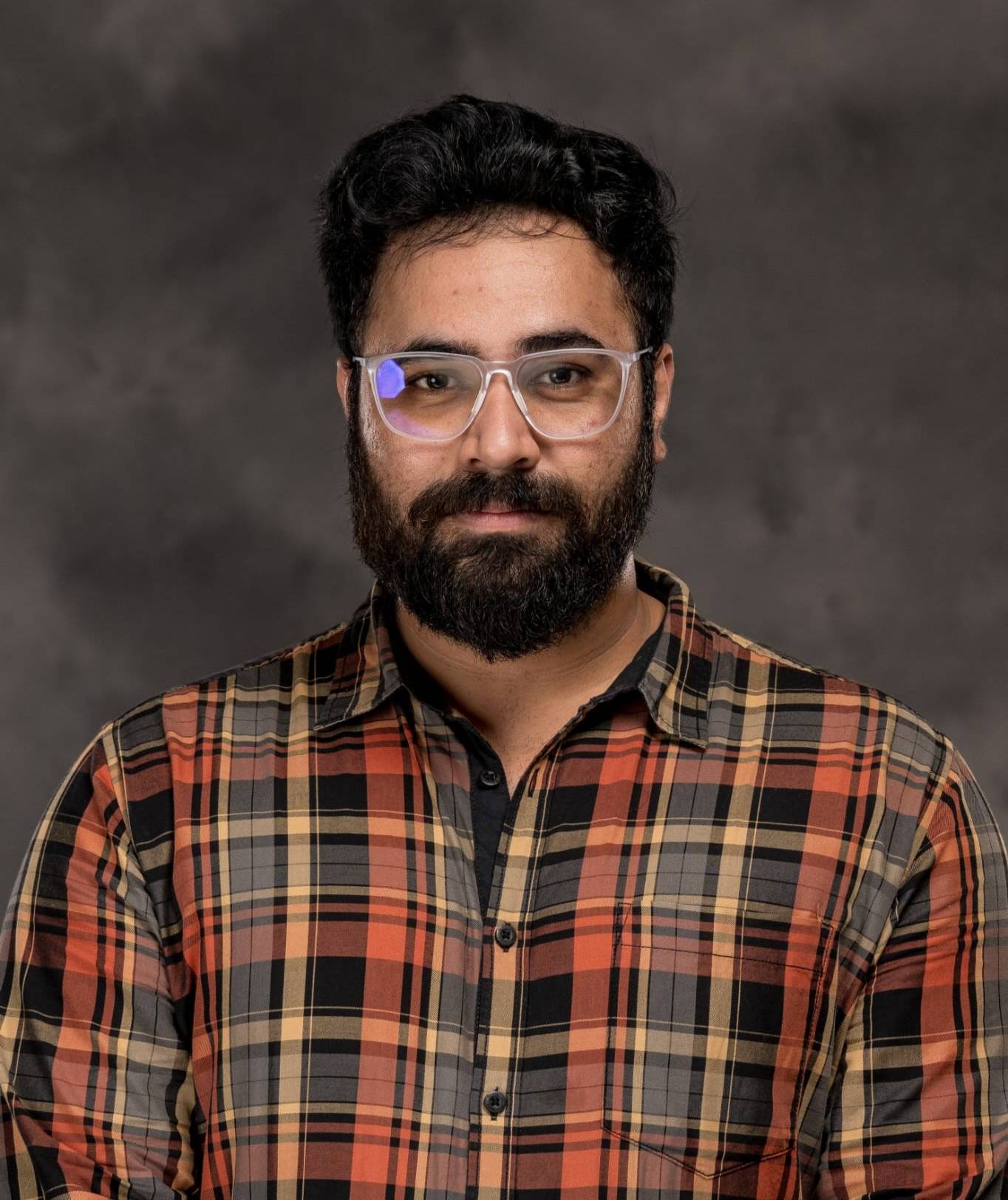
Dr. Sudhanshu Sharma is an accomplished cancer biologist currently serving as an American Cancer Society (ACS) Postdoctoral research associate. His research centers on deciphering the mechanism of cancer signaling, identifying suitable drug targets, and repurposing by integrating a multi-omics approach.
Dr. Sharma earned his Ph.D. from the Department of Biotechnology at Delhi Technological University, Delhi, India. His doctoral research was supported by the prestigious DST-INSPIRE fellowship, reflecting his strong academic credentials and innovative research contributions. Before his postdoctoral role, he worked as a Research Scientist-I at the Institute of Nuclear Medicine and Allied Sciences (INMAS), Defense Research and Development Organization (DRDO), India, contributing significantly to radiation biology and therapeutic countermeasure studies. With expertise spanning mammalian cell culture, radiation biology, and in vivo models (C57/BL-6 mice, Balb/c mice, Wistar rats, gerbils, Sprague Dawley rats, Duncan Hartley guinea pig and rabbits), Dr. Sharma is also proficient in computational and bioinformatics techniques, including artificial intelligence (AI)-driven machine learning models, molecular docking, and molecular dynamics (MD) simulations for drug discovery and repurposing.
Dr. Sharma was awarded a University Gold Medal for his master’s in Biochemistry, underlining his academic excellence. His contributions to oncology and computational biology are reflected in his scholarly publications, which have garnered many citations.
Publication Details:
|
Publications till date |
Citations |
h-index |
i10-index |
|
10 |
225 |
7 |
5 |
Google Scholar link:
https://scholar.google.com/citations?hl=en&user=7lnF96QAAAAJ&view_op=list_works&sortby=pubdate
ORCID id: https://orcid.org/0000-0003-4251-3923
Sreelakshmi Krishnakumar, Ph.D., Postdoctoral fellow
Email: skrishnakumar@alasu.edu
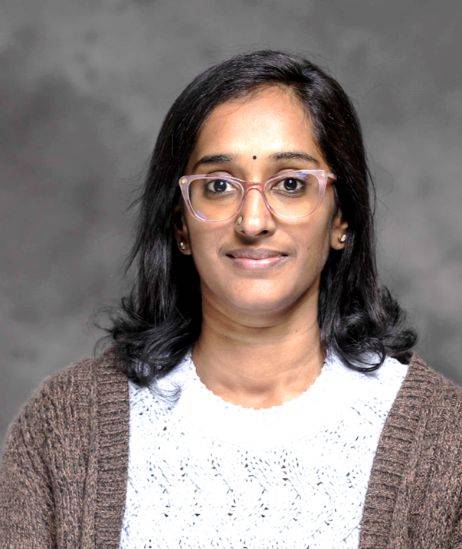
Dr. Sreelakshmi Krishnakumar graduated with a Ph.D. in Life Sciences from Amrita Vishwa Vidyapeetham, India, in August 2022. Her research explored the transgenerational effects of graphene-derived nanoparticles in the reproduction and development of Japanese medaka. Soon after, she joined as a research associate in the design and development section of a pilot-scale clinical study funded by the Department of Biotechnology (DBT), Government of India. The work focused on the synthesis, characterization, and quality assessment of a biomimetic jawbone scaffold for application in jawbone augmentation and regeneration following GMP regulatory compliances.
She joined Alabama State University in December 2023 as a postdoctoral research associate in the Cancer Biology Research and Training Program. Her research interest is to explore circadian variations in the rhythmic profiles of clock-controlled genetic and epigenetic factors in prostate cancer. This can accentuate potential chronotherapeutic interventions to help develop transformative advancements in disease prognosis and therapy.
Azura Murphy, M.S. candidate
Email: amurphy4593@myasu.alasu.edu
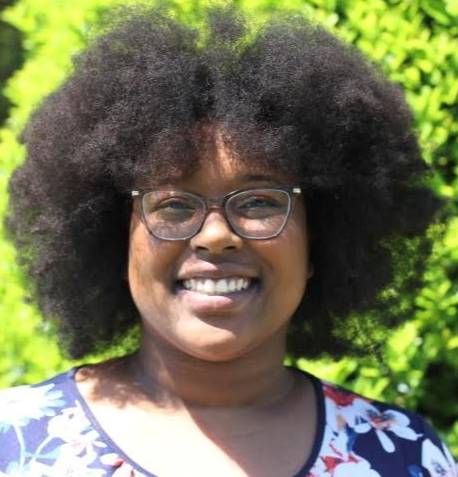
Degree status: Bachelor of Biological Science with molecular concentration from Auburn University at Montgomery. She is currently a master’s candidate in the biological science department at Alabama State University. Previous work consisted of discovering the metabolic reprogramming of ovarian cancer cell lines in response to leptin. Current works consist of investigating the effects of GLP-1 agonist orlistat and chemotherapeutic doxorubicin on human prostate cancer cell line DU145.
Arkimberly Jiles, Project Manager
Email: ajiles@alasu.edu
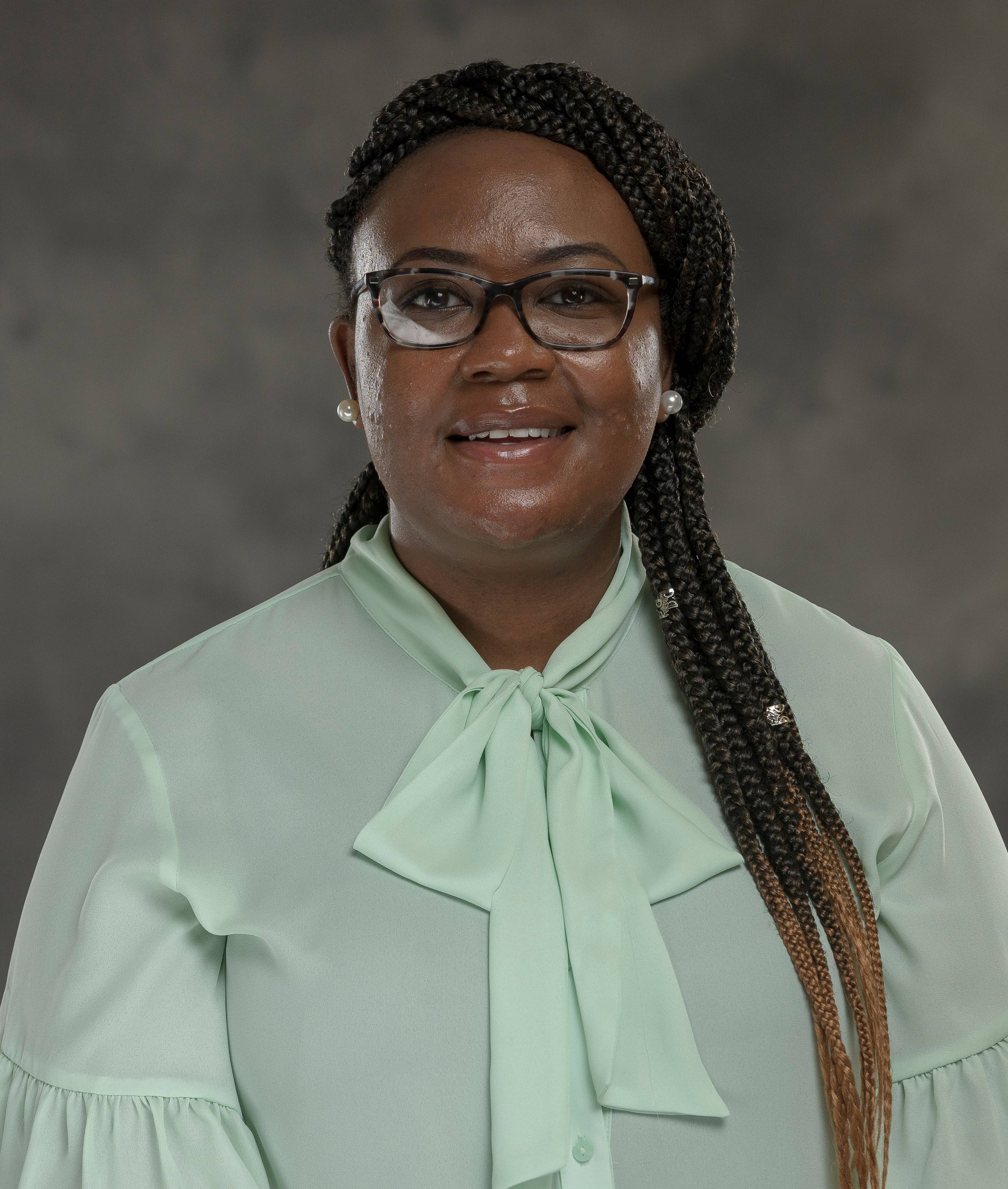
Arkimberly Jiles graduated from Auburn University and now serves as a project manager at Cancer Research Center. She manages undergraduate and graduate student recruitment activities and lab requirements such as chemicals, reagents, instruments, and other lab stuff.
Past Lab members
Shalie Malik, Ph.D.: Dr. Malik is currently a Professor of Zoology at the University of Lucknow, India. She is also the director of Dr. Giri Lal Gupta Institute of Public Health and Public Affairs at the University of Lucknow.
Nivedita Priyadarshini, Ph.D., Research Scientist: Current position unknown
James Stokes III, Ph.D.: Dr. Stokes works as Scientist II at AbbVie.
Sanjay Kumar, Ph.D.: Dr. Kumar is working as a scientist at Southern Research Institute.
Chand B. Davuljigari, Ph.D.: The current designation is not available.
Anurag Singh, Ph.D.: Dr. Singh is a research associate at the Indian Institute of Technology at Banaras Hindu University, India.
Brittany Hollins, MS: Ms. Hollins is an Evaluation specialist at Alabama State University.
Eric Berry II, MS: Mr. Berry is a laboratory technician at BioEnergy in Memphis, TN.
Jazmyn Gregg, Rotating graduate student: Currently pursuing Ph.D.
Ibrahim Alamin, Rotating graduate student: Currently pursuing Ph.D.
CURRENT GRANT SUPPORT (Funded):
240913 (Mishra-PI), 12/1/2024-11/30/2027, 1 Calendar Month, National Science Foundation
Excellence in Research - Design and develop an affordable point-of-care device using a functionalized carbon dot biosensor to diagnose non-invasive early lung cancer. ($500K)
BCRFA grant (Mishra PI). 1/1/2025-12/31/2026, 0.1 calendar month, Breast Cancer Research Foundation of Alabama,
Nanostructured Copper Oxide Aptasensor for Noninvasive Early Detection of 8-oxo-dG in Breast Cancer Diagnosis.
DICRIDG-22-1037199-01DICRIFG) (Mishra-PI), 01/01/2023-12/31/2026, 0.4 Calendar months, American Cancer Society ($2.7M)
Enhancing Cancer Research Capacity at Alabama State University
This proposal aims to enhance the overall cancer research capacity at ASU.
1 R25 AG070244-01A1, (Mishra-PI), 09/01/2022-08/31/2027, 2.0 Calendar months, NIH/NIA
Alabama State University-Auburn University Partnership to Promote Diversity in Aging Research ($1.45M)
The overarching objectives of the proposal are 1) To develop educational Geo Information System (GIS) modules and its impact in aging research and 2) to provide academic and summer research experiences to STEM undergraduate students.
U01 GM132769-01, (Mishra-PI), 07/01/19-06/30/24, 3.0 Calendar months, NIH/NIGMS
Intersection of Social Capital, Mentorship and Networking on Persistence, Engagement
and Science Identity ($2.9M)
The overarching objectives of this proposal are to test: 1) the effects of pre-existing personal and contextual factors on the participation of undergraduate students from diverse backgrounds in the biomedical workforce, 2) test whether mentoring/networking intervention, mainly in first-year students and sophomore years, influence the persistence, engagement, and development of science identity of students from diverse backgrounds. Our proposal focuses on Historically Black Colleges and Universities (HBCUs) geographically distributed with different individual- and neighborhood-level socioeconomic factors.
1912322, (Mishra-PI), 07/01/19-06/30/23 (NCE), 0.5 Calendar months, National Science Foundation
Transforming Biology Laboratory Learning through the Development, Deployment, and Assessment of Evidence-based Research and learning (EBRL) Experiences ($400K)
The main goal of this proposal is to design an evidence-based curriculum at ASU and to provide research interventions to underserved freshmen/sophomore students in cutting-edge research in biomedical disciplines.
COMPLETED GRANT SUPPORT (Since 2012)
Grant number: AIM-AHEAD NIH (Suman-PI, Mishra-Site PI), Funding agency: NIH/NIMHD Title: Evaluating bias in predictive and explainable ML algorithms among older adults with cancer. ($74K). Duration: 09/01/2022-04/30/2024. Goal: This proposal aims to analyze data using GIS and understand how this data helps advance health equity and reduce cancer disparity.
Grant Number: AEOP-REAP, Funding agency: Army Educational Programs-Research and Engineering Apprenticeship Program, Title: The Research and Engineering Apprenticeship Program (REAP) at Alabama State University, Role: REAP site Project Director, Duration: 2018-2021, Goal: The main goal of this project was to train and expose high school students during the summer to cancer research.
Grant Number: 1510479, Funding agency: National Science Foundation, Title: RUI: Spatially and Compositionally Gradient Scaffolds for Anterior Cruciate Ligament, Role: Co-Principal Investigator, Duration: 08/01/2015-08/31/2020, Goal: To conduct biomedical research.
Grant Number: P20CA192976, Funding Agency: National Cancer Institute, National Institutes of Health Institute, Title: 2/2 Alabama State University/UAB Comprehensive Cancer Center partnership (P20), Role: Principal Investigator, Duration: 10/01/2014-09/30/2019, Goal: The main objective of this proposal was to foster partnership with 'UAB's comprehensive cancer center and start a cancer research, education, and training program at Alabama State University in the areas of colorectal and prostate cancer to eliminate health disparity in minority populations.
Grant Number: PC150726, Funding Agency: US department of Defense, Title: Diversifying Biomedical Researchers in Prostate Cancer through Academic Affiliations between UNTHSC and Alabama State University, Role: Co-Principal Investigator, Duration: June 2016-2019, Goal: The project provided training to 16 undergraduate STEM students during summer in prostate cancer research at UNTHSC.
Grant Number: ASU-CON PARTNER, Funding agency: Conversant Bio, Title: Alabama State University-Conversant Bio Partnership, Role: Principal Investigator, Duration: 2014-2019, Goal: This project fostered partnership between academia and industry to engage undergraduate and graduate students in cancer research.
Grant Number: W911NF-14-1-0064, Funding agency: US Department of Defense, Title: Acquisition of a flow cytometry system to enhance undergraduate research and STEM education, Role: Principal Investigator, Duration: 01/01/2014-12/31/2016, Goal: The primary purpose of this project was to acquire a flow cytometer to enhance research and education at Alabama State University.
Grant Number: LICOR-ODYSSEY, Fundign agency: LiCor Biosciences, Title: Science Undergraduate Research Award, Role: Principal Investigator, Duration: March 2016-December 2016, Goal: The primary purpose of this project was to acquire an Odyssey imaging system to enhance research and education at Alabama State University.
Grant Number: W911NF-12-1-0073 supplement, Funding agency, US Department of Defense, Title: URAP supplement: Multifunctional Polymeric Scaffolds for Bone-Tissue Regeneration, Role: Principal Investigator, Duration: Summer of 2015 and 2016, Goal: The main objective of this project was to train and expose undergraduate STEM students during summer in the area of bone-tissue regeneration and cancer research.
Grant Number: W911NF-12-1-0073, Funding Agency: US Department of Defense, Title: Multifunctional Polymeric Scaffolds for Bone-Tissue Regeneration, Role: Principal Investigator, Duration: 2/24/2012-2/23/2016, Goal: The main goal of this proposal was to develop scaffolds that mimic the characteristics of the Extracellular matrix and its role in molecular pathways in bone tissue regeneration processes.
Grant Number: W911NF-12-1-0073 HSAP supplement, Funding agency: US Department of Defense, Title: HSAP supplement: Multifunctional Polymeric Scaffolds for Bone-Tissue Regeneration, Role: Principal Investigator, Duration: Summer of 2015 and 2016, Goal: The primary purpose of this project was to train and expose undergraduate STEM students during summer to bone-tissue regeneration and cancer research.
Grant Number: 1154214, Funding Agency: National Science Foundation, Title: Scholarships to promote retention and graduation rates in STEM Disciplines, Role: Principal Investigator, Duration: 9/15/2012-8/31/2018, Goal: The main goal of this proposal was to provide scholarships to undergraduate STEM students to increase the graduation and retention rate at Alabama State University. This grant provided scholarships to 130 STEM undergraduate students and supported tutoring services at ASU.
Recent Publications (2009-onwards)
- Kaur P, Singh SK, Mishra MK, Singh S, Singh R. Nanotechnology for boosting ovarian cancer immunotherapy. Journal of Ovarian Research. 2024 Oct 14;17(1):202. PMCID: PMC11475952
- Haque M, Shyanti RK, Mishra MK. Targeted therapy approaches for epithelial-mesenchymal transition in triple negative breast cancer. Frontiers in Oncology. 2024 Oct 10; 14:1431418. PMCID: PMC11499239
- Prabhjot Kaur, Santosh Kumar Singh, Manoj K Mishra, Shailesh Singh, Rajesh Singh (2024) Promising Combinatorial Therapeutic Strategies against Non-Small Cell Lung Cancer. Cancers (Basel), 2024 Jun 12;16(12):2205. doi: 10.3390/cancers16122205. PMCID: PMC11201636
- Sahu M, Ambasta RK, Das SR, Mishra MK, Shanker A, Kumar P. Harnessing Brainwave Entrainment: A Non-invasive Strategy To Alleviate Neurological Disorder Symptoms. Ageing Research Reviews. 2024 Oct 16:102547. PMCID: PMC39419401
- Souvanik Talukdar, Santosh K Singh, Manoj K Mishra, Rajesh Singh (2024) Emerging Trends in Nanotechnology for Endometriosis: Diagnosis to Therapy. Nanomaterials (Basel) 2024 Jun 5;14(11):976. PMCID: PMC11173792
- Nivedita Priyadarshni, Rajesh Singh, Manoj K Mishra (2024) Nanodiamonds: Next generation nano-theranostics for cancer therapy. Cancer Letters. 2024 Apr 10:587:216710. PMCID: PMC10961193
- Ritis K Shyanti, Jazmyn Greggs, Shalie Malik, Manoj Mishra (2024) Gut dysbiosis impacts the immune system and promotes prostate cancer. Immunol Letters. 2024 Aug: 268:106883. PMCID: PMC11249078
- Sunayana Nath, Ritis Kumar Shyanti, Rana Pratap Singh, Manoj Mishra, Bhawana Pathak (2024) Thespesia lampas mediated the green synthesis of silver and gold nanoparticles for enhanced biological applications. Front. Microbiol., 05 January 2024, Volume 5, PMCID: PMC10832436
- Rajan Kumar Tiwari, Shiv Govind Rawat, Vishal Kumar Gupta, Pradip Kumar Jaiswara, Pratishtha Sonker, Santosh Kumar, Vibhav Gautam, Manoj K Mishra, Ajay Kumar (2023) Epinephrine facilitates the growth of T cell lymphoma by altering cell proliferation, apoptosis, and glucose metabolism. Chem Biol Interact, 2023 Jan 5:369:110278, PMID: 36423730
- Shalie Malik, James Stokes III, Upender Manne, Rajesh Singh, Manoj K.Mishra (2022) Understanding the significance of the biological clock and its impact on cancer incidence. Cancer Letters, Volume 527, 28 February 2022, Pages 80-94
- Seela Aladuwaka, Ram Alagan, Rajesh Singh, Manoj K Mishra (2022) Health Burdens and SES in Alabama: Using Geographic Information System to Examine Prostate Cancer Health Disparity. Cancers,9/2022, 14(19), 4824; PMID: 36230747
- James Stokes III, Sankalp Vinayak, Jazalyn Williams, Shalie Malik, Rajesh Singh, Upender Manne, Taofeek K. Owonikoko, Manoj K. Mishra (2021) Optimum health and inhibition of cancer progression by microbiome and resveratrol. Frontier of Biosciences Front Biosci (Landmark Ed) 2021 January 1; 26:496-517.
- Bassel Nazha, Subir Goyal, Zhengjia Chen, Anne Engelhart, Jennifer Wilkinson Carlisle, Tyler Beardslee, Harpaul Gill, Levani Odikadze, Yuan Liu, Manoj K. Mishra, Suresh S. Ramalingam, Taofeek Kunle Owonikoko (2020) Efficacy and safety of immune checkpoint blockade in self-identified Blacks with advanced non-small cell lung cancer (NSCLC). Cancer. DOI: 10.1002/cncr.33141.
- Santosh K. Singh, Manoj K. Mishra, Brian M. Rivers, Jennifer B. Gordetsky, Sejong Bae, and Rajesh Singh (2020) Biological and Clinical Significance of the CCR5/CCL5 Axis in Hepatocellular Carcinoma. Cancers (Basel). Cancers, Apr; 12(4): 883.
- Bassel Nazha, Manoj Mishra, Rebecca Pentz, and Taofeek K. Owonikoko (2019) Enrollment of Racial Minorities in Clinical Trials: Old Problem Assumes New Urgency in the Age of Immunotherapy. American Society of Clinical Oncology Educational Book, Volume 39, pages: 3-10.
- Santosh Kumar Singh, Manoj Kumar Mishra, Rajesh Singh (2019) Hypoxia-inducible factor-1α induces CX3CR1 expression and promotes the epithelial to mesenchymal transition (EMT) in ovarian cancer cells. J Ovarian Res. 2019 May 10;12(1):42.
- Abron JD, Singh NP, Murphy AE, Mishra MK, Price RL, Nagarkatti M, Nagarkatti PS, Singh UP (2018) Differential role of CXCR3 in inflammation and colorectal cancer. Oncotarget. 9(25):17928-17936, PMID: 29707158.
- Abron JD, Singh NP, Mishra MK, Price RL, Nagarkatti M, Nagarkatti PS, Singh UP (2018) An endogenous aryl hydrocarbon receptor (AhR) ligand, ITE induces regulatory T cells (Tregs) and ameliorates experimental colitis. Am J Physiol Gastrointest Liver Physiol. DOI: 10.1152/ajpgi.00413.2017 PMID: 29672155.
- Andrew Wood, Dominique Everett, Sanjay Kumar, Manoj Mishra, and Vinoy Thomas (2018) Fiber Length and Concentration: Synergistic Effect on Mechanical and Cellular Response in Wet-Laid poly(lactic acid) Fibrous Scaffolds. J Biomed Mater Res B Appl Biomater. DOI: 10.1002/jbm.b.34125 PMID: 29656479.
- Sanjay Kumar, Sanjeev Gurshaney, Yori Adagunodo, Erica Gage, Shezreen Qadri, Mahak Sharma, Shalie Malik, Upender Manne, Udai P. Singh, Rajesh Singh, Manoj K. Mishra (2018). Hsp70 and γ-Semino Protein as possible prognostic markers of prostate cancer. Frontiers in Biosciences. 987-2000.
- Singh SK, Mishra MK, Eltoum IA, Bae S, Lillard JW Jr., Singh R. (2018) CCR5/CCL5 axis interaction promotes migratory and invasiveness of pancreatic cancer cells. Sci Rep. 2018 Jan 22;8(1):1323. PMCID: PMC5778036
- Sanjay Kumar, Rajesh Singh, Shalie Malik, Upender Manne, Manoj Mishra (2017) Prostate cancer health disparities: An immuno-biological perspective. Cancer Letters. 414:153-165, PMID: 29154974.
- Bo Wang, Wuwei Li, Derrick Dean, Manoj K. Mishra, and Kennedy S. Wekesa (2017) Enhanced Hepatogenic Differentiation of Bone Marrow-Derived Mesenchymal Stem Cells on Liver ECM Hydrogel. Journal of Biomedical Materials Research Part A. Published online on October 25, 2017, DOI: 10.1002/jbm.a.36278
- Sanjay Kumar, James Stokes III, Udai P Singh, Karyn Scissum-Gunn, Rajesh Singh, Upender Manne, Manoj K Mishra (2017) Prolonged exposure of resveratrol induces reactive superoxide species–independent apoptosis in murine prostate cells. Tumor Biology. 39(10): 1-10. DOI: 10.1177/1010428317715039 [PMCID not found]
- Kumar S, Eroglu E, Stokes III JA, Gunn KS, Saldanha SN, Singh UP, Manne U, Ponnazhagan S, Mishra MK. (2017) Resveratrol induces mitochondria-mediated, caspase-independent apoptosis in murine prostate cancer cells. Oncotarget. 8(13):20895-20908, PMCID: PMC5400554
- Shamran H, Singh NP, Zumbrun EE, Murphy A, Taub DD, Mishra MK, Price RL, Chatterjee S, Nagarkatti M, Nagarkatti PS, Singh UP (2017) Fatty acid amide hydrolase (FAAH) blockade ameliorates experimental colitis by altering microRNA expression and suppressing inflammation. Brain, Behavior, and Immunity. 59:10-20, PMCID: PMC5154806
- Sanjay Kumar, James A. Stokes III, Derrick Dean, Christian Rogers, Elijah Nyario, Vinoy Thomas, and Manoj K. Mishra (2017) Biphasic organo-bioceramic fibrous composite as a biomimetic extracellular matrix for bone tissue regeneration. Frontiers in Biosciences. 9: 192-200. PMID: 28199184
- Anil Shanker, Menaka Thounaojam, Manoj K Mishra, Mikhail M Dikov (2017) Innate-Adaptive Immune Crosstalk 2016. Journal of Immunology Research. 1-2. PMCID: PMC5405582
- Sanjay Kumar, James Stokes III, Udai P. Singh, Karyn Scissum Gunn, Arbind Acharya, Upender Manne, Manoj Mishra (2016) Targeting Hsp70: A possible cancer therapy. Cancer letters. 374:156–166. PMID: 26898980
- Anil Shanker, Menaka C Thounaojam, Manoj K. Mishra, Mikhail M. Dikov and Roman V. Uzhachenko (2015) Innate-Adaptive Immune Crosstalk. Journal of Immunology Research. 1-2. PMCID: PMC5405582
- Maria Teresa P. de Aquino, Anshu Malhotra, Manoj K. Mishra, and Anil Shanker (2015) Challenges and future perspectives of T cell immunotherapy in cancer. Immunology Letters. 19; 166(2):117-133. PMCID:PMC4499494
- Udai P. Singh, Angela E. Murphy, Reilly T. Enos, Haidar A. Shamran, Narendra P. Singh, Honbing Guan, Venkatesh L. Hegde, Daping Fan, Robert L. Price, Dennis D. Taub, Manoj K. Mishra, Mitzi Nagarkatti, and Prakash S. Nagarkatti (2014) MicroRNA-155 deficiency protects mice from experimental colitis by reducing Th1/Th17 responses. 143(3):478-489. PMCID:PMC4212960
- Amanee D. Salaam, Manoj Mishra, Elijah Nyairo, and Derrick R. Dean. (2014) Electrospun polyvinyl alcohol/nanodiamond composite scaffolds: morphological, structural, and biological analysis. Journal of Biomaterials and Tissue Engineering. 4:73-180. DOI: 10.1166/jbt.2014.1152
- Singh UP, Singh NP, Guan H, Busbee B, Price RL, Taub DD, Mishra MK, Fayad R, Nagarkatti M, Nagarkatti PS. (2014) The Emerging Role of Leptin Antagonist as Potential Therapeutic Option for Inflammatory Bowel Disease. Int Rev Immunol. 33:(1):23-33. PMCID:PMC4159716
- James Stokes III, Udai P. Singh, Elijah Nyairo, Manoj K. Mishra (2013) Resveratrol and its impact on Prostate cancer. International Journal of Advanced Biotechnology & Bioinformatics. 2:6-13. [not found]
- Erica G. Schmitt, Dipica Haribhai, Jonathan C. Jeschke, Dominic O. Co, Jennifer Ziegelbauer, Ke Yan, Yoichiro Iwakura, Manoj K. Mishra, Pippa Simpson, Nita H. Salzman, and Calvin B. Williams (2013) Chronic Follicular Bronchiolitis Requires Antigen-Specific Regulatory T Cell Control to Prevent Fatal Disease Progression. Journal of Immunology. 191:5460-5476. PMCID: PMC3893829
- Udai P. Singh, Narendra P. Singh, Honbing Guan, Venkatesh L. Hegde, Robert L. Price, Dennis D Taub, Manoj K. Mishra, Mitzi Nagarkatti, & Prakash S. Nagarkatti (2013) The severity of experimental autoimmune cystitis can be ameliorated by anti-CXCL10 Ab treatment. PLOS One, 8(11):e79751. PMCID: PMC3836899
- Singh UP, Singh NP, Guan H, Busbee B, Price RL, Taub DD, Mishra MK, Fayad R, Nagarkatti M, Nagarkatti PS. (2013) Leptin antagonist ameliorates chronic colitis in IL-10-/- mice. Immunobiology. 218(12):1439-1451. PMCID: PMC3778116
- Udai P. Singh, Narendra P. Singh, Brandon Busbee, Guan, H, Robert L. Price, Dennis D. Taub, Manoj K. Mishra, Mitzi Nagarkatti, and Prakash S. Nagarkatti (2012) Microbial Links to Inflammatory Bowel Disease Development: Potential Interventional Strategies in Treatment. Journal of Bacteriology and Parasitology. 3:7. [not found]
- Renu Bhatt, Vinoy Thomas, Derrick Dean, Elijah Nyairo, Udai P. Singh, and Manoj K. Mishra (2012) Role of PPARs as Chemotherapeutics and Anticancer molecules. International Journal of Advanced Biotechnology & Bioinformatics. 1:11-18. [not found]
- Himani D. Deshpande, Derrick R. Dean, Vinoy Thomas, William C. Clem, Moncy V. Jose, Elijah Nyairo, and Manoj K. Mishra. (2012) Carbon nanofiber reinforced polycaprolactone fibrous meshes by electrostatic co-spinning. Current Nanoscience. 8(6):753-761. DOI: 10.2174/157341312802884409
- Amanee Salaam, Manoj K. Mishra, Elijah Nyairo, and Derrick Dean (2012) Morphological and Biological Characterization of PVA-Nanodiamond Electrospun Fibers. Polymeric Materials: Science and Engineering. 106:334-335. doi:10.1166/jbt.2014.1152
- Udai P. Singh, Narendra P. Singh, Brandon Busbee, Guan, H, Balwan Singh, Robert L. Price, Dennis D. Taub, Manoj K. Mishra, Mitzi Nagarkatti, and Prakash S. Nagarkatti (2012) Alternative medicines as emerging therapies for inflammatory bowel diseases. International Reviews of Immunology. 31(1):66-84. PMCID: PMC4138959
- Himani Deshpande, Carrie Schindler, Derrick Dean, William Clem, Susan Bellis, Elijah Nyairo, Manoj K. Mishra, Vinoy Thomas (2011) Nanocomposite scaffolds based on electrospun polycaprolactone/modified carbon nanofiber/ nanohydroxyapatite by electrophoretic deposition. Journal of Biomaterials and Tissue Engineering. 1:177-184. DOI: 10.1166/jbt.2011.1024
- Udai P. Singh, Narendra P. Singh, Balwan Singh, Manoj K. Mishra, Mitzi Nagarkatti, Prakash S. Nagarkatti, and Singh S.R. (2010) Stem Cell in Inflammatory Bowel Disease and its Therapeutic Implication. Frontiers in Bioscience. 1(2):993-1008. [not found]
- Srikanta Jana, Parthav Jailwala, Dipica Haribhai, Jill Waukau, S Glisic, William Grossman, Manoj K. Mishra, Ren Wen, D Wang, Calvin B Williams, S Ghosh. (2009) The role of NF-kappaB and Smad3 in TGF-beta-mediated Foxp3 expression. European Journal of Immunology. 39(9):2571-83. PMID:19701891
- Lance M. Relland, Manoj K. Mishra, Dipica Haribhai, Brandon Edwards, Jennifer Zeigelbauer, and Calvin B. Williams (2009). Affinity-based selection of regulatory T cells occurs independently of agonist-mediated induction of Foxp3 expression. Journal of Immunology. 182(3):1341-1350. PMCID: PMC2818884
Book Chapters
- Shriti Singh, Manoj Kumar Mishra, and Rajesh Singh (2018). Epigenetic Modulations in Ovarian Cancer. Elsevier publication, Saldanha S. Ed. 2018, P169–193.
- Sanjay Kumar, Rajesh Singh, Manoj K. Mishra (2018). Genetic and Epigenetic Modifications in Pancreatic Cancer. Elsevier publication, Saldanha S. Ed. 2018, Pages 117–140.
- Sanjay Kumar, James A. Stokes III, Udai P. Singh, and Manoj K. Mishra (2016) Ezh2, an epigenetic regulator: The future of prostate cancer treatment. In: Epigenetic Advancements in Cancer. Editors-Mishra and Bishnupuri, Springer International Publishing AG, Gewerbestrasse 11, 6330 Cham, Switzerland, 2016; p229-245.
- James A. Stokes III, Sanjay Kumar, Karyn Scissum-Gunn, Udai P. Singh, and Manoj K. Mishra (2016) Epigenetic and cancer: An evaluation of the impact of dietary components. In: Epigenetic Advancements in Cancer. Editors-Mishra and Bishnupuri, Springer International Publishing AG, Gewerbestrasse 11, 6330 Cham, Switzerland, 2016; p65-78.
- Kumar S Bishnupuri and Manoj K. Mishra (2016) Epigenetics of Colorectal Cancer. In: Epigenetic Advancements in Cancer. Editors-Mishra and Bishnupuri, Springer International Publishing AG, Gewerbestrasse 11, 6330 Cham, Switzerland.
- James A. Stokes III and Manoj K. Mishra (2014) Role of resveratrol (RES) in regenerative medicine. In: Diverse Applications of Nanotechnology in Biomedicine, Chemistry, and Engineering. IGI Global, Hershy, PA Chapter 18, pages 392-402.
- Shree Ram Singh, Manoj K. Mishra and Chhavi Chauhan (2012) Cell Transplantation in Chronic Kidney Disease. In: Cell Transplantation: New Research, Nova Science Publisher, Inc., New York, 978-1-62100-542-1, Page 1-24.
- Shree Ram Singh, Manoj K. Mishra, Maduri Kango-Singh and Steven X. Hou (2012) Generation and Staining of Intestinal Stem Cell Lineage in Adult Midgut. Methods in Molecular Series, Somatic STEM cells: Methods in Molecular Biology,879: 47-69.
- Shree Ram Singh and Manoj K. Mishra (2012) JAK/STAT Signaling in Cell Fate and Tumorigenesis. In: Signaling, gene regulation and cancer, Nova Science Publisher, Inc., New York, ISBN: 978-1-61942-092-2, Chapter 4, pages 63-72.